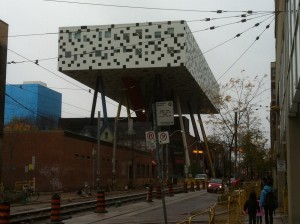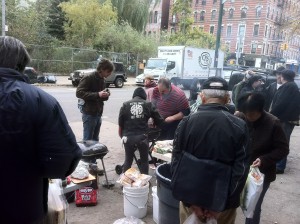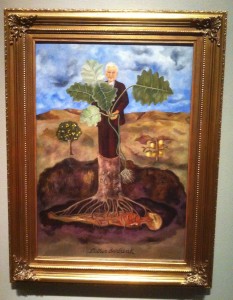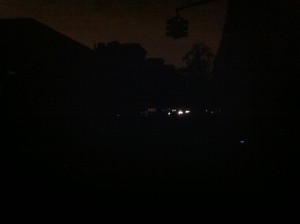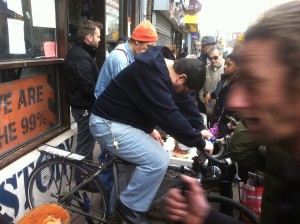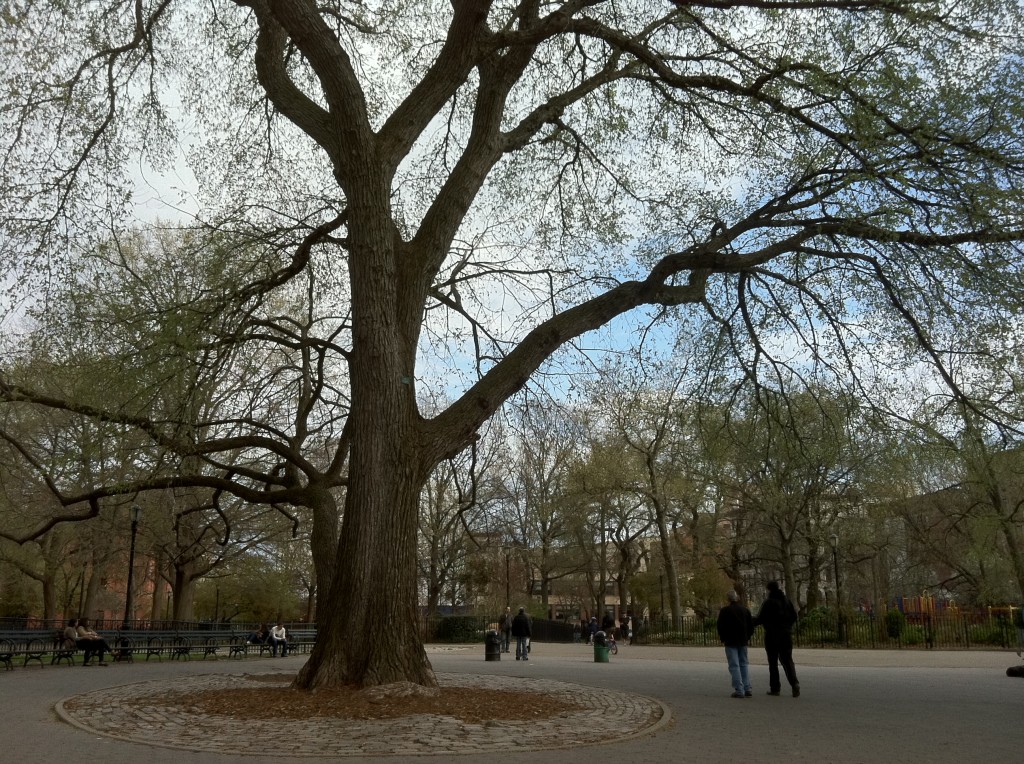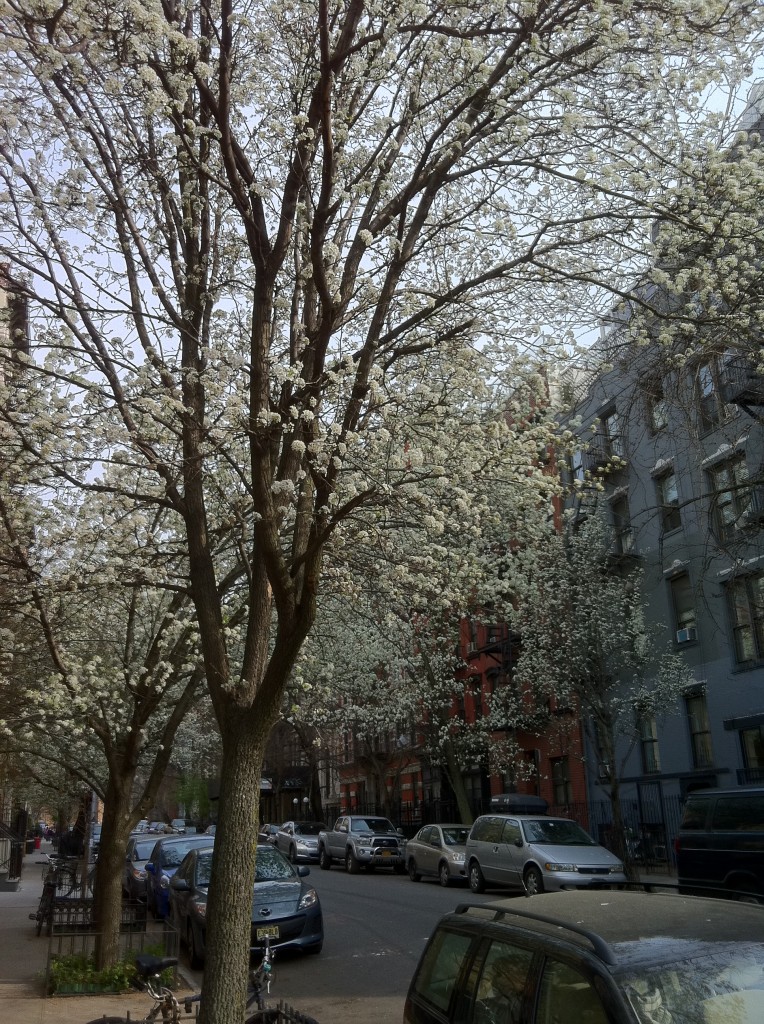Though I was headed back to New York, Hurricane Sandy had other ideas and I got stuck in my hometown of Toronto for a few days, waiting for NYC’s airports to reopen. I have to say it was refreshing to hear a Jamaican guy outside the Lansdowne subway station cursing at random passersby, calling them ‘bloodclots’ as they rushed for the bus. Life on the West Coast is just so insufferably white bread and I miss these idiomatic Caribbean speech patterns, not to mention the great goat and okra rotis I tucked into at Vena’s – the local hole-in-the-wall Trinidadian place. Don’t even get me started about the West Coast’s lack of subways….
I had come to Ontario in the first place to attend a thirty-two year reunion of my long dead punk band ‘The Enemas’ (wince, wince) which happened in the smallish rust belt city of London. Though my own memories of 1979-81 were a bit on the sketchy side, my former band mates managed to play through our set with astonishing verve. Though I am less than sure of my musical talent these days, it was heartening to share memories of those early punk days with former demimondaines and be introduced to a whole new generation of aficionados who weren’t even born when we last played. More than anything, it is the punk rock aesthetic that has stuck with me all of these years – a sense of anti-authoritarian glee and the joy of improvisation; of not doing things by the book. For that sense of empowerment, I am eternally grateful.
Back in Toronto after the London event, my hurricane-induced hiatus allowed me to reacquaint myself with old Hog town, the city that essentially molded me as a young artist and writer. As well as viewing a lovely exhibition at the AGO, (curated by my old friend Dot Tuer) of works by Frida Kahlo and Diego Rivera, I swanned about some of the neighbourhoods I used to frequent and I couldn’t help noticing, (as I sometimes do after absences from once familiar places) that the remnants of my physical past – the buildings, the faces I once knew – have receded strangely into an aggregated matrix of history, obscuring what was once there – what is still in my mind – like a translucent veil or an alternate quantum state that oscillates in and out of the present like the cronosthesia suffered by Chris Marker’s protagonist in La Jetée. One of the few consolations to getting older I find, is that this ability, in one’s mind’s eye, to zoom in and out through one’s own history becomes astonishingly acute. The present more and more resembles the skin of some translucent, temporal onion, containing the nested layers of the past still glistening inside it, each existing as it once was, but within the corpus of a unified whole.
And that goes for the future too because as Baudrillard pointed out, the unimaginable has always been imagined to some extent. Which brings me to New York. Finally! After days of hurricane Sandy induced flight cancellations, the flooding had receded from the airport runways enough that I was able to board a plane for the short flight. Upon arrival at La Guardia, at first everything seemed more or less normal, but as the taxi crossed the Williamsburg bridge into the Loisaida it was as if I had entered a parallel, crepuscular universe. Though it was already early evening, there was no electric light to be seen anywhere and it felt as if I had traveled backward in time to some earlier, pre-electrical Manhattan. Traffic signals and street lights were all out and the windows of the storefronts and apartment buildings stared darkly into the shadowy streets. Knots of people sauntered along the sidewalks, at much slower than the usual frenetic Manhattan pace, and here and there as a diminished reminder of the historical present, a tiny cell phone screen glowed from the darkness, borne by unseen hands in search of what had become almost a memory of formerly ubiquitous reception.
As night fell further, I could see the darkness would absolute, save for vehicle headlights, a few wavering flashlights and the twinkle of candles in the windows of the occasional bar that stayed open, catering to the many in the neighbourhood who suddenly didn’t have much to do, except shiver in their cold, dark apartments. Being the nexus of entrepreneurialism that New York is, there were itinerant ice men driving around (where do they come from so suddenly?) hawking their now highly coveted wares to whomever would agree to their exorbitant prices.
“Ice – Ten dollars a bag!”
But cold beer is a welcome distraction from any disaster and I soon found myself atop a bar stool, enjoying a Pabst Blue Ribbon around the glow of a tiny tea candle in the otherwise Stygian darkness of Avenue B at 7th Street, joined by a friend from our building and a professional pet sitter named Nanette who drank her gin and tonic with a snuffling pug named Olive, perched on her lap like a furry, drooling accordion.
The next morning, the power was still out but I could see that the urban immune system had kicked in. While the ConEd trucks and National Guard vehicles went about their business, the punks at 9th and C have had barbecues going in front of their building and were attending to the many hungry people in the neighbourhood who had been having to make do without light, heat and in many cases water for these three days. The corner was one of the only localities in the neighbourhood in which get a cell-phone signal so it was full of people milling around with their handsets pressed to their ears or frantically texting. To my delight, the punks had provided a pedal-powered cell phone charger next to their outdoor kitchen, helping us all to maintain our tenuous links to the outside world.
Go Punks!
I’m so glad to report that at 9th and C at least, the punk spirit is alive and well and maybe it’s stronger now than ever. As climate change continues to heave and buckle the aging infrastructure of American capitalism, it is these anti-authoritarian ragamuffins who will increasingly be called upon to step up and save us. Welcome to the future. I think I like it!
Update: Though the power came on Friday night for many buildings here in Alphabet City, things are still very much sucking for the folks in the nearby PJs, many of whom live along the East River where the worst flooding happened. Along with the lack of light and heat, these unfortunates had to endure the exceptional torment of not having running water. To me, this was yet another object lesson on how, within the context of climate change and the general lack of readiness of North America’s tax-starved, aging infrastructure, it will be the poor who will disproportionately bear the brunt of what is coming. Tuesday’s coming election here can be seen as a referendum on how America views its social contract. Will the state make some committment to its historical responsibility to look after those less fortunate, or will be headed for a more brutal, individualist future? No matter what the outcome, I think we’ll be needing the spirited, do-it-yourself public service of those punk kids more and more.


